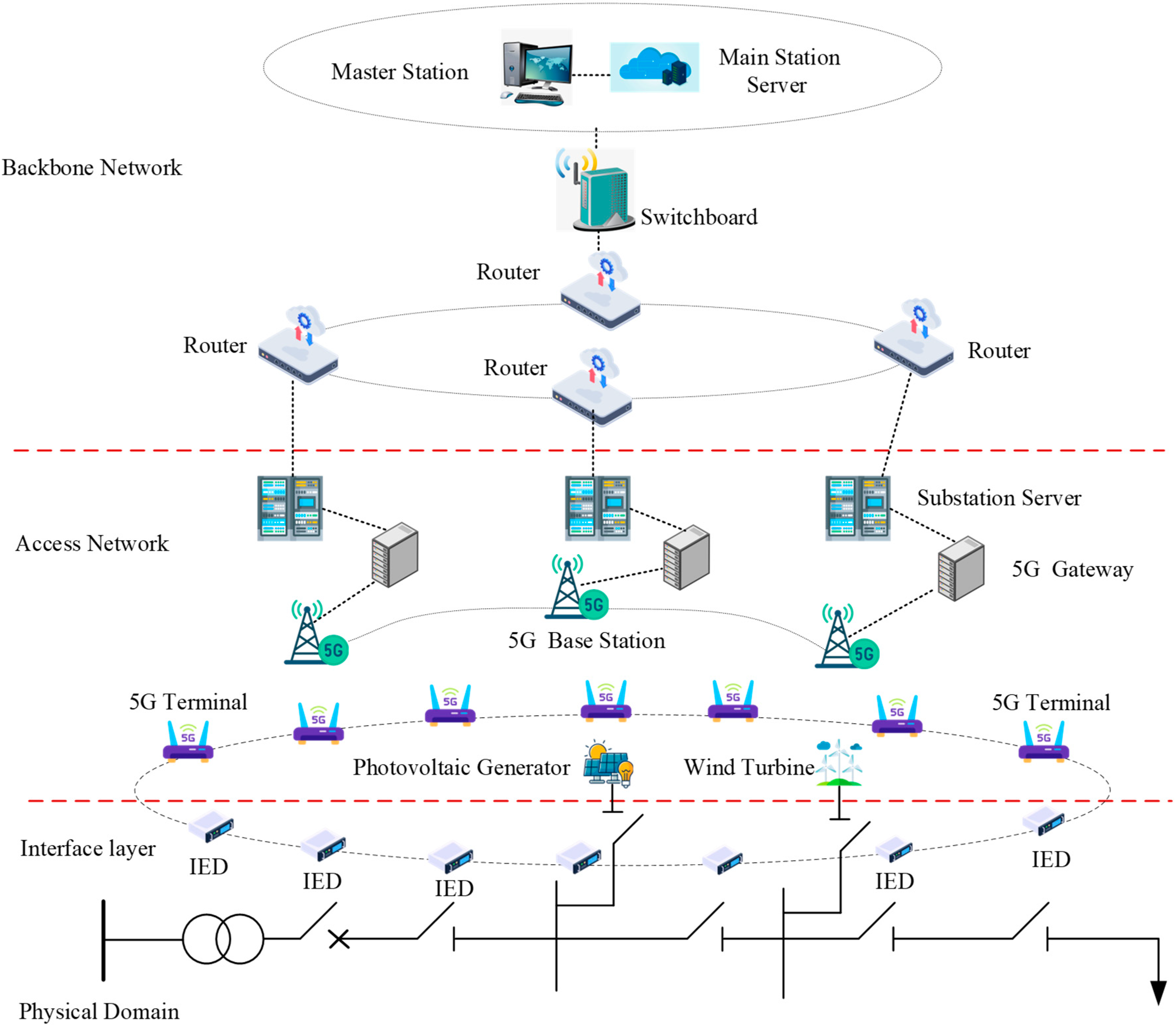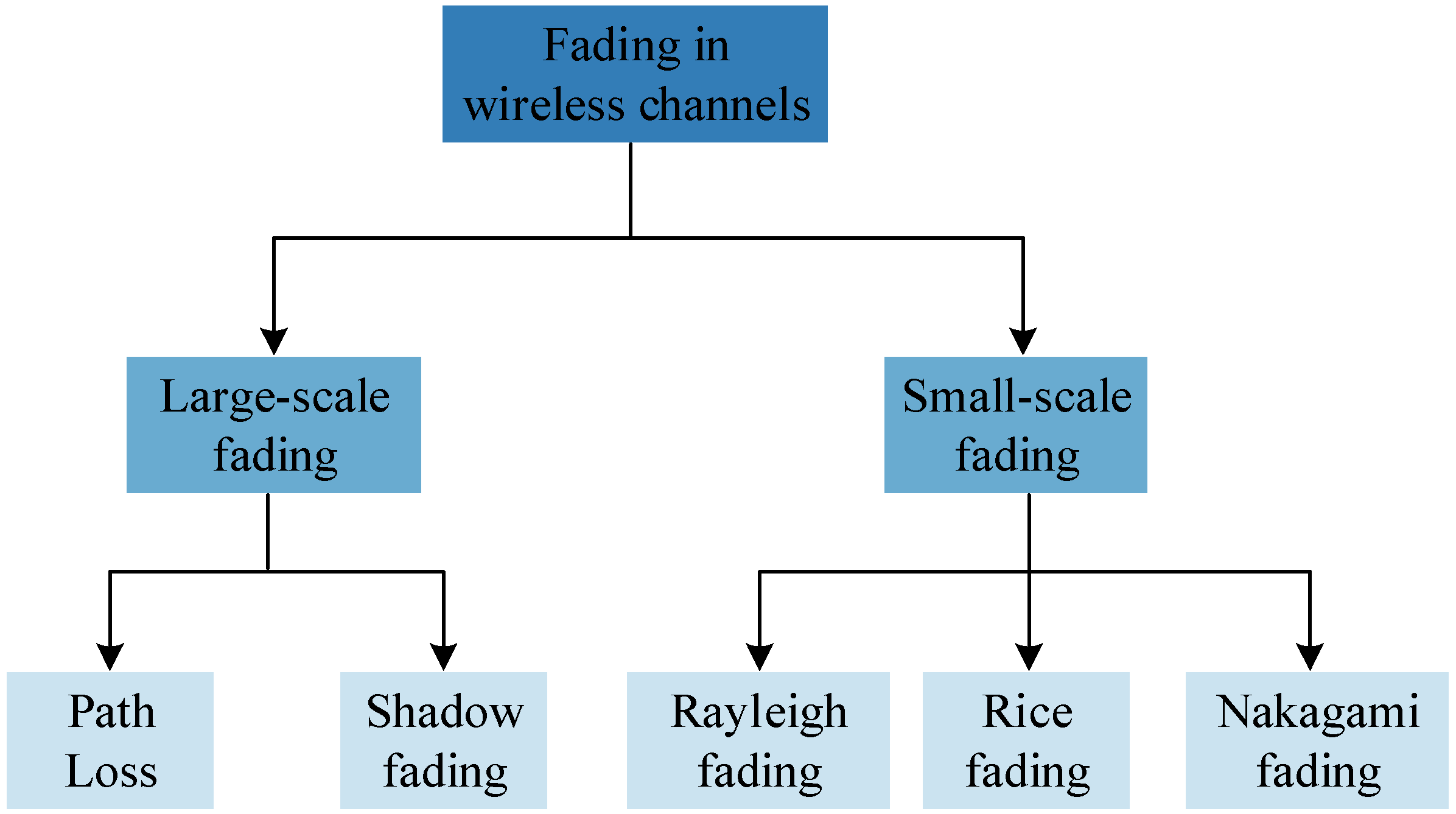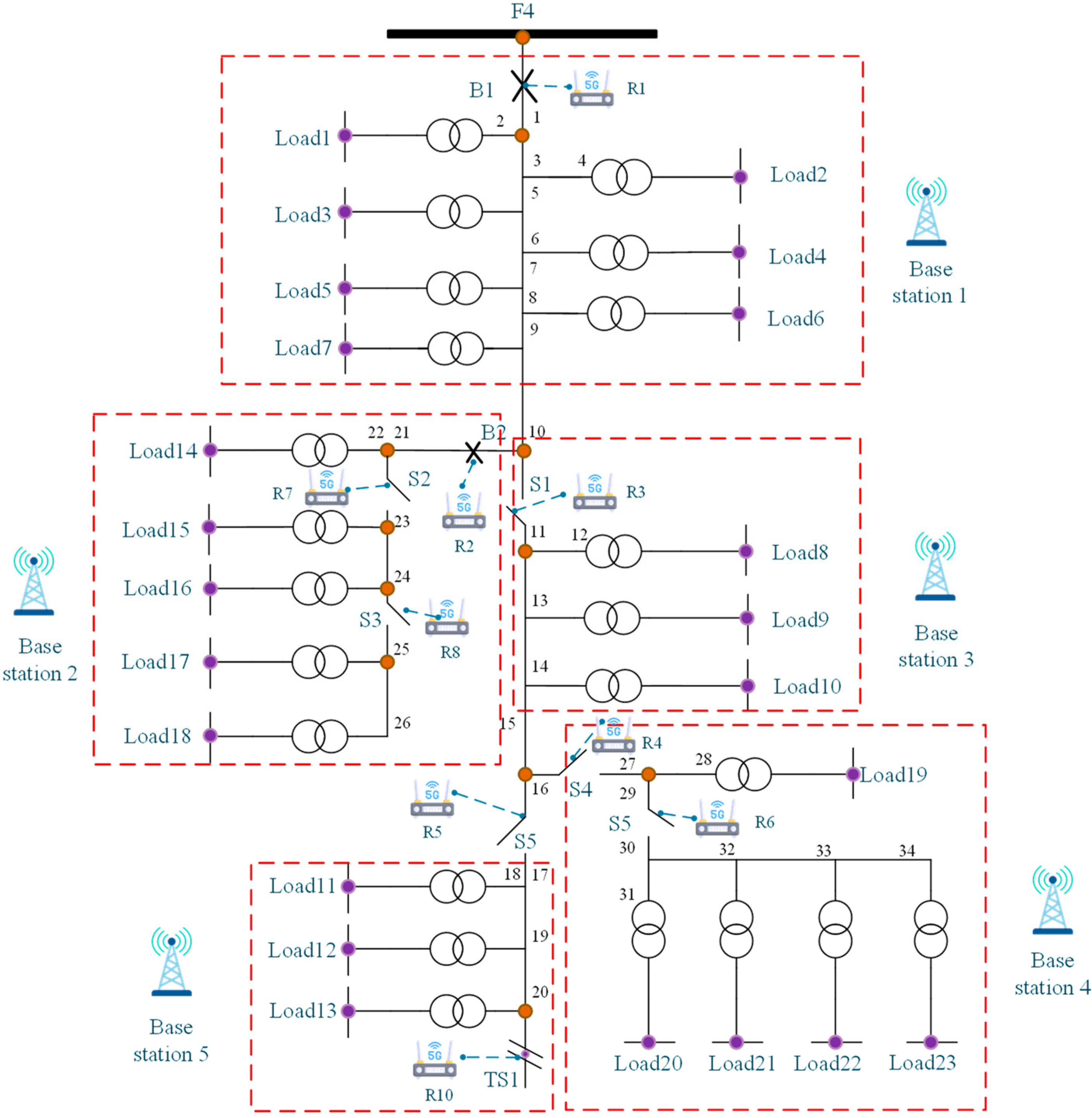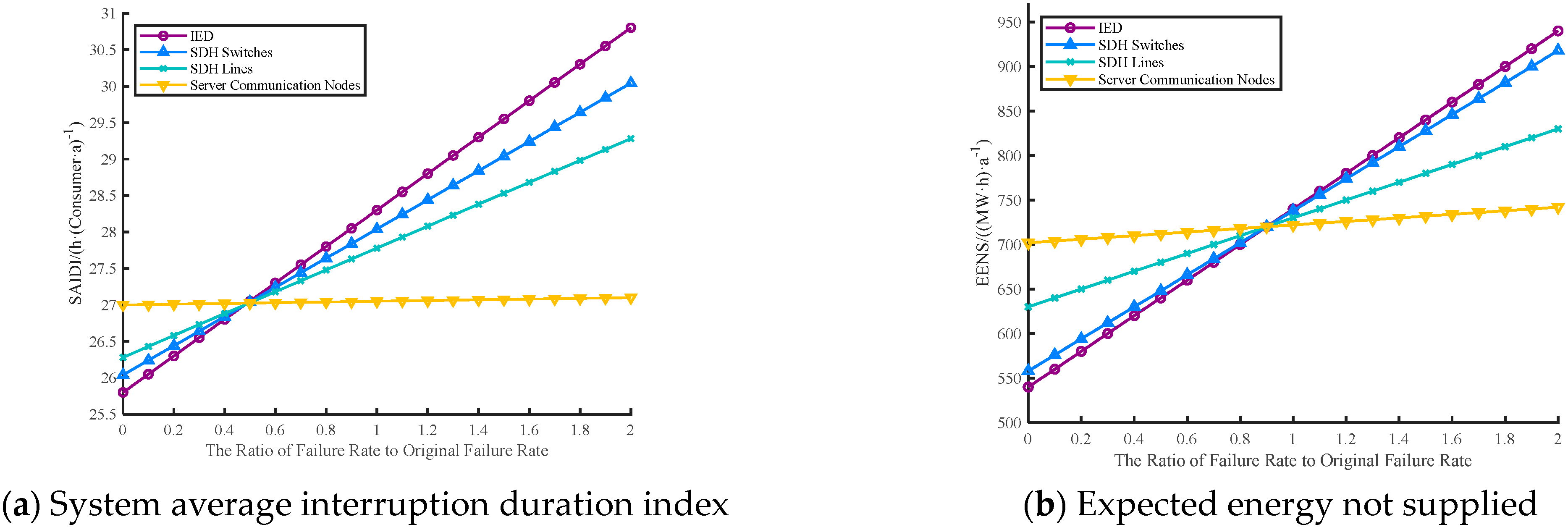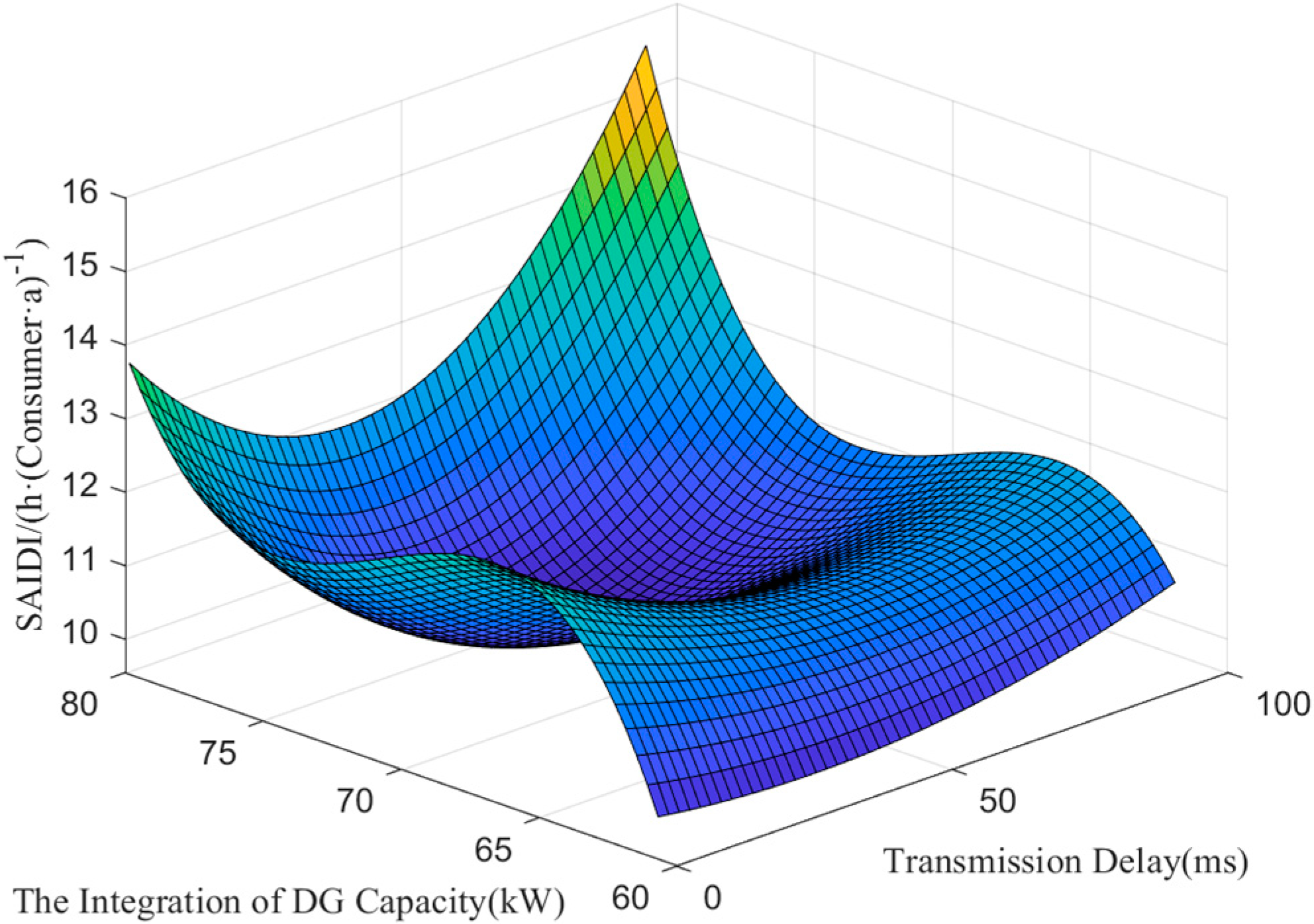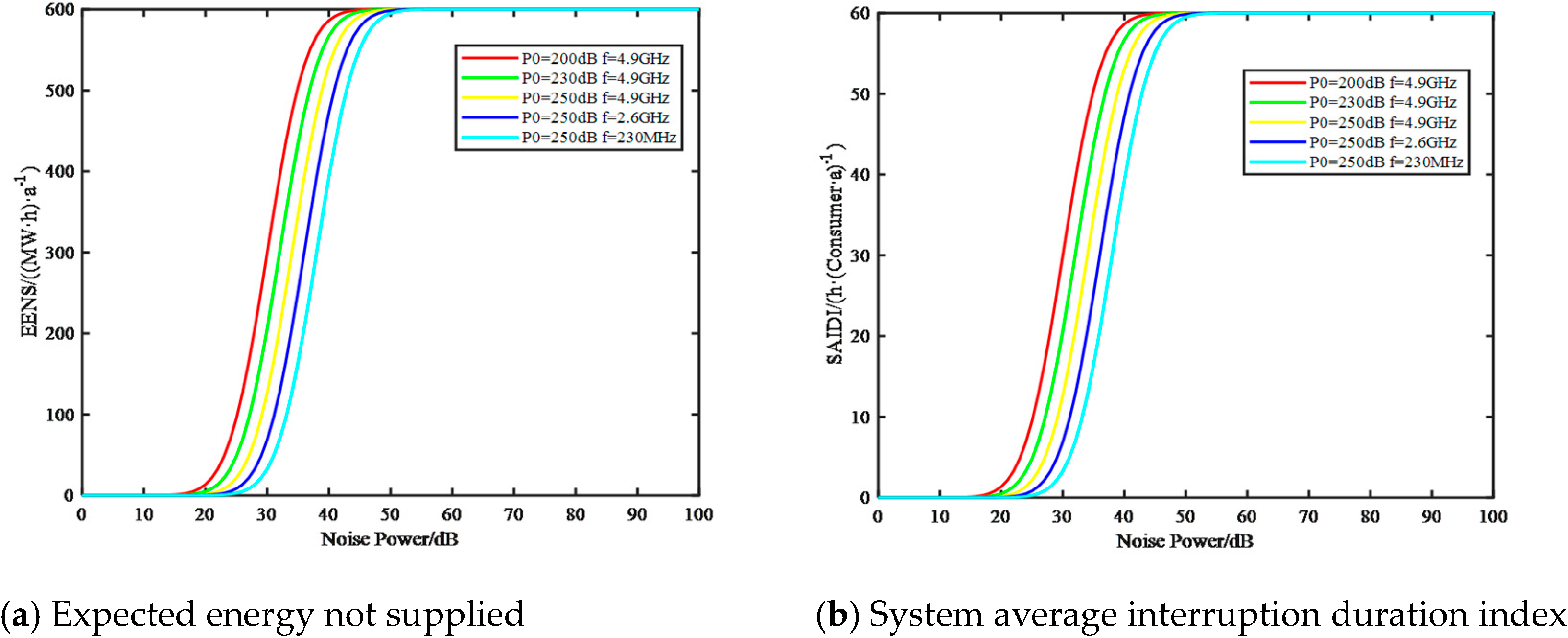1. Introduction
With the continuous development of new types of power systems, the number of terminal devices in power distribution systems is growing explosively, and dependence on communication networks is also increasing to fulfill the communication requirements of the power sector [
1]. Currently, CPDSs typically employ wireless and wired communication methods to monitor and control the data on the physical side to ensure the reliable operation of the system. Although wired communication technologies, such as fiber optic communication, have the advantages of high reliability and security, they also have the disadvantages of high investment, difficult construction, and difficult access in certain physical environments.
The wireless communication technology represented by 5G is considered a key technology supporting CPDSs. Research has shown that compared to traditional wired communication, 5G wireless communication technology provides more flexible deployment options, especially in remote or complex terrain areas, where fiber optics are difficult to lay. This helps to reduce deployment costs and time. 5G technology provides highly reliable communication connections, which are crucial for the stable operation of power systems. The reliability of communication networks directly affects the continuity and security of power supply. The low latency characteristics of 5G networks enable them to support real-time or near-real-time control and monitoring applications, which is crucial for quickly responding to faults and abnormal situations in a power system. The high data transmission rate of 5G networks supports the fast transmission of large amounts of data, which is very useful for handling the large amount of monitoring and control data generated in power distribution systems. Although wireless communication technology provides significant advantages, the integration of CPDSs also brings new challenges. Due to the increasing dependence of physical systems on cyber systems in urban distribution networks, it is important to accurately assess the reliability of the impact of the failure of the information communication system under the conditions of wireless network access. The impacts of information systems in physical systems are categorized as direct and indirect effects.
The direct impact implies that information perturbations (e.g., information component failures and network attacks) can immediately lead to physical failures. Researchers have studied this by building corresponding reliability models. Literature [
2] constructed a reliability assessment framework for distribution networks considering multiple types of information perturbations (e.g., cyber attacks, information component failures, and information transmission anomalies) by analyzing the consequences of information perturbations on information systems. Literature [
3] constructed a reliability assessment model considering information component damage, transmission delay, and transmission error by analyzing the impacts of information system anomalies on the physical system.
Traditional reliability assessment methods may not fully capture the unique characteristics of physical information systems. Therefore, researchers have developed new methods, such as machine learning-based predictive models, to improve the accuracy and efficiency of evaluations. Literature [
4] proposed a reliability evaluation method and indicators for CPDSs in distribution networks, taking into account network interference. The study proposed a reliability modeling method that combined fault tree and Petri net to simulate the reliability of distribution network CPDSs and defined a generalized reliability index for distribution network CPDSs, considering network interference. Literature [
5] established a multi-state reliability model based on the failure scenarios of coupled components and used a full binary tree topology traversal method to model distribution network information failure scenarios. Literature [
6] proposed a multidimensional network model that used the fault location, isolation, and supply restoration (FLISR) processes as an interface between PDS and DIS. The study constructed a path search method based on the transfer matrix by defining the composite multi-node attributes and the system transfer matrix. Literature [
7] considered the impact of sensing terminal faults in information systems on distribution networks. The study proposed a reliability evaluation method for multi-voltage level distribution networks that took into account the effects of sensing terminal faults. The sequential Monte Carlo simulation method was used for reliability evaluation. The above literature has preliminarily explored the impact of cyber systems on physical systems in active distribution networks, but the analysis of the impact of information systems on physical systems is still not sufficiently in-depth.
The focus of research in recent years has shifted to indirect impacts. Literature [
8] proposed a reliability evaluation method based on region-based DFA (Distributed Feedline Automation) analysis. This method had high computational efficiency in large-scale CPDSs. The article analyzed the impact of network system anomalies on reliability in DFA mode and constructed a network reliability model by considering two factors: network device failures and network attacks. Literature [
9] analyzed the impact of information system failures on the reliability of distribution networks under the DFA mode. It also proposed a fast reliability assessment method for CPDSs. However, compared to the research on direct impacts, indirect impacts still require further exploration and in-depth study.
It is often difficult for a system to adapt to the complexity of the actual distribution network in real distribution network scenarios. Moreover, most of the existing reliability models for CPDSs are based on some simplified assumptions, which cannot accurately assess the reliability of complex situations in real engineering applications. Literature [
10] categorized the factors that affect the reliability of the smart microgrid (SMG) for information systems into network failures and information transmission failures. By modeling the interdependence and information transmission failures between information systems and physical systems, a reliability assessment of the SMG was conducted. Literature [
11] proposed a CPDN (cyber–physical distribution network) reliability assessment method that considered the interdependence between physical and cyber systems throughout the fault-handling process. The study established a sequential fault handling reliability model and corresponding results based on a fault tree that considered the influence of the network and proposed two metrics for assessing the network’s impact on DG (distributed generation) scheduling capability. Literature [
12] established reliability models for components and two systems and summarized the mapping relationship between various network system faults and physical fault-handling. It transformed them into several laws and proposed a reliability assessment procedure in the framework of the Monte Carlo method.
Literature [
13] proposed a new information flow modeling and computation method, which established an information flow matrix by defining the network operating parameters as the flow accumulation function, information flow rate, and time delay. Literature [
14] established a reliability model for distribution network components based on cyber–physical systems (CPSs) and proposed a multi-state model for intelligent electronic devices (IEDs). Literature [
15] simultaneously considered information uncertainty and multi-energy coupling characteristics to establish the basic architecture of an active CPDS, a reliability model of information domain components, and a model for analyzing the effectiveness of information transmission. Literature [
16] proposed a sequential multi-stage cooperative recovery strategy for CPS failures caused by natural disasters. It considered the interdependence between cyber and physical systems at the facility, topology, and functional layers and the coupling relationship between grid integration and the recovery process. Literature [
17] proposed a reliability modeling and assessment method for power information systems (i.e., cyberspace in the power system), in which a composite Markov model coupled physical properties and information flow performance in a two-layer model. Literature [
18] deeply analyzed the communication system requirements to support the operation of a distribution network. The study demonstrated the high reliability and economic advantages of wireless communication technology in CPDSs. From the perspective of multi-layer networks, literature [
19] proposed an evaluation method for the importance of communication nodes. The study focused on the operational characteristics of nodes in communication systems and the dynamic propagation of faults between homogeneous communication nodes. However, the impact of communication system reliability on physical system reliability was not thoroughly analyzed. Literature [
20] studied the interdependence between information systems and physical systems in a multi-microgrid CPDS. It proposed a reliability evaluation framework based on Monte Carlo simulation. Research has shown that information systems have a significant impact on the reliability of physical systems, but there is no systematic study on the reliability assessment of a CPDS under wireless access network conditions.
The above literature emphasizes the impact of the integration of information systems and physical systems on the reliability of distribution networks. They all take wired access networks as the research object and establish corresponding CPDS reliability evaluation models. At present, research on CPDSs under wireless network access is still in its infancy. Based on the findings of existing research, our work aimed to fill the gap in the existing research and propose a new evaluation method to more accurately simulate and evaluate the reliability of a CPDS under wireless communication network conditions. As stated above, the key contributions of this paper are as follows.
(1) An analytical method was used to model the reliability of the information system components, communication channel reliability, and communication delay reliability of the 5G communication network, and the factors affecting the reliability of wireless communication networks are expressed analytically.
(2) This paper establishes a reliability model of multiple switches in the physical system based on the analysis of the indirect impact of information failure on the physical system.
(3) The reliability model took into account the self-healing treatment of faults, islanding operation, contact lines, load transfer, and the impact of DG access. The reliability assessment was carried out by utilizing the improved least square path method. The results of this study are close to the operation of a CPDS in practice.
2. Channel Reliability Modeling for 5G Communications
2.1. Structure of the CPDS
The information domain of the CPDS included the protocols, software, and topology used in the information and communication equipment and communication network. The physical domain included the traditional primary equipment and new energy equipment such as photovoltaic and wind power as well as the energy storage equipment, and its structure is shown in
Figure 1.
In the figure, the information domain is divided into the backbone network and the access network. The backbone network adopted the SDH (synchronous digital hierarchy) transmission protocol to connect the power distribution master station and substations. The access network adopted the 5G wireless network based on the IEC104 protocol to connect the distribution electronic station and intelligent electronic devices. The control command of the information layer determined the operation state of the physical layer, and the operation state of the physical layer determined the data input of the information layer, and there was a close interaction between the two.
The application layer realized the analysis and processing of information (decision generation) and human–computer interaction and was located in the main power distribution station (or substation). The communication layer was divided into two parts, namely, the distribution of electronic stations between the control center and the backbone communication network. It mainly adopted fiber optic SDH or a multi-service transmission platform (MSTP) ring network structure, with multiple channels and multiplexing layers. The access communication network from the substation to the distribution terminal, also known as the distribution communication network, adopted various communication methods such as Ethernet, power line carrier, wireless, etc. The interface layer included the first section of the feeder. The interface layer included the feeder first section protection device, feeder terminal unit (FTU), distribution terminal unit (DTU), inverter, and other intelligent distribution terminals.
Due to the structure of CPDSs, wireless communication technology can serve as a supplement to wired communication, providing additional communication paths. When wired networks fail, wireless networks can serve as backups to ensure the continuous transmission of critical information, thereby improving network redundancy and reliability.
2.2. Wireless Channel Model
In wireless communication networks, to study the performance of the network, the most important thing is to test the reliability of the network communication channel, so it is necessary to establish a reasonable wireless channel model. Before studying the channel of the network, it is necessary to understand the propagation characteristics of electromagnetic waves in the wireless channel. The wireless channel is a very complex dynamic channel, electromagnetic wave propagation in space is mainly direct, reflective, scattered, diffracted, etc. Electromagnetic waves through the wireless channel will produce attenuation so that the signal strength received at the receiving end is weakened; this phenomenon is called fading.
To provide a more intuitive explanation of the fading phenomenon in wireless channels, we created
Figure 2.
Figure 2 shows that the fading of wireless channels mainly includes large-scale fading and small-scale fading. Large-scale fading includes path loss and shadow fading, while small-scale fading mainly includes Rayleigh fading.
Path loss is directly proportional to propagation distance and is influenced by the propagation environment. High path loss can lead to a decrease in the power of the received signal, thereby reducing the signal-to-noise ratio (SNR) and affecting signal demodulation and correct data reception. Shadow fading is a random signal attenuation caused by large obstacles (such as buildings) during the propagation of wireless signals, usually modeled as a log-normal distribution. This can lead to uneven signal coverage. Some areas may experience a significant decrease in signal strength due to signal obstruction, affecting communication quality. Rayleigh fading is a small-scale fading model used to describe the rapid changes of wireless signals in multi-path environments, typically used to simulate wireless channels in urban environments. This kind of fading can lead to rapid fluctuations in the signal, affecting its stability and reliability, especially in high-speed data transmission. In this study, a composite channel fading model considering path loss and shadow fading was used to study the reliability of wireless networks.
In a wireless communication network, all data packets are used to transmit information over a wireless channel. The source node and the nth (n
) relay node are called node 0 and node n, respectively, and the destination node is called node N + 1. Suppose node n (n
) sends a signal to node n + 1. The quality of the received signal can be measured by the SNR at the receiving end, which can be expressed as
where
is the transmit power of node n.
denotes the background noise power of the receiver.
denotes the channel gain of the wireless channel between node n and node n + 1, which, in dB form, can be expressed as
where
means 10
.
G is a dimensionless constant indicating the path loss coefficient at the reference point
, the value of this parameter depends on the characteristics of the antenna as well as the average channel attenuation.
indicates the power loss index of the wireless channel, the value of which depends on the area and environment where the wireless channel is located, and its value usually ranges from 2 (in free space) to 6 (in the urban downtown area) [
21].
indicates the reference distance (the reference point must be in the far-field area of the antenna).
indicates the straight line distance between node n and node n + 1 (the reference point must be in the far-field area of the antenna).
denotes the shadow fading of the signal, and, usually,
obeys the log-normal distribution.
is a normally distributed random variable with a mean of 0 and variance of
. In wireless communication, to ensure the accuracy of the received signal, the SNR of the received signal is usually required to be more than a certain threshold, expressed mathematically as
where
denotes the desired SNR threshold.
2.3. Reliability Analysis of Wireless Channels
The probability of successful signal transmission is defined as the probability that the SNR of the signal does not fall below the SNR threshold. Thus, the channel reliability between node n and node n + 1 can be defined as
Substituting (2) into the above equation, we get
where the parameter
can be expressed as
The function (5)
in the formula represents the error function. The error function is defined as
The function
is the cumulative distribution function (CDF) of the standard normal distribution function, which is defined as
From the system model, it can be seen that to ensure the reliability of the signal reception, each packet is repeatedly sent
K times, so the probability that node n + 1 successfully receives a packet from node n can be expressed as
The function erfc(
x) represents the complementary error function, which is defined as
Furthermore, Formula (9) can be used to derive the link reliability of the entire wireless sensor network as
6. Conclusions
Considering the reliability of wireless information transmission in distributed network physical systems, this article proposed a reliability evaluation method for distributed cyber systems based on wireless access networks. It provided a new idea for quantifying information transmission performance reasonably and quickly. Based on the established switching model, this paper proposed a reliability calculation method combining the upward equivalence and the minimum path method, which greatly improved the calculation efficiency. Finally, a test system was established to verify the impact of information transmission performance on distribution network reliability, which verified the correctness and efficiency of the proposed method, and the main conclusions are as follows:
(1) Among the information system components, the variation in the failure rate of IEDs has the greatest impact on CPDS reliability.
(2) Information system failures cause a small decrease in the reliability of active distribution networks, and the allocation of distributed new energy generation devices with reasonable capacity to CPDSs is conducive to improving the reliability of system power supplies.
(3) As the average load rate of the wireless access network increases, the number of withdraws of the channel detection increases, which will directly lead to the increase in information transmission delay, the probability of information link failure becomes larger, and the reliability of the CPDS decreases.
(4) One notable limitation is the potential compatibility issue between 5G technology and existing wired communication infrastructures in traditional power distribution networks. Additionally, the high investment and construction challenges in certain physical environments may pose barriers. However, these limitations can be bypassed through strategic planning and incremental upgrades to the existing network, alongside cost–benefit analyses and collaborative efforts with stakeholders to facilitate a smoother transition to 5G-enabled power distribution systems.
For subsequent research, we are preparing to introduce machine learning algorithms into the reliability assessment of power distribution physical systems to extend machine learning integration for predictive maintenance in a cyber–physical system.
